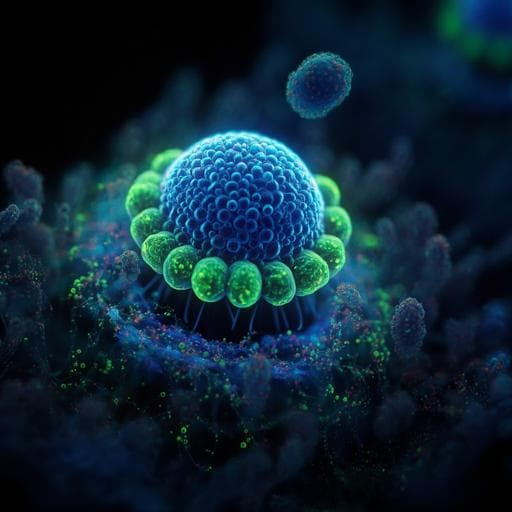
Environmental Studies and Forestry
The efficacy of chlorine-based disinfectants against planktonic and biofilm bacteria for decentralised point-of-use drinking water
G. E. Clayton, R. M. S. Thorn, et al.
This fascinating research by Gillian E. Clayton, Robin M. S. Thorn, and Darren M. Reynolds explores the power of chlorine-based disinfectants in enhancing the safety of drinking water. Discover how hypochlorous acid outperformed others in battling *E. coli*, while electrochemically activated solutions excelled against *P. aeruginosa* biofilms, pointing to promising alternatives for point-of-use drinking water applications.
~3 min • Beginner • English
Introduction
A major source of human disease is via the consumption of biologically contaminated water, particularly in low- and least-developed countries with limited access to basic sanitation. In contrast, upper-middle and high-income countries generally use centralized treatment and distribution systems, with chlorine (commonly as sodium hypochlorite, NaOCl) widely used due to low cost and effective antimicrobial properties. Residual chlorine (0.5–5 mg L⁻¹) helps prevent regrowth, and indicator organisms (e.g., E. coli, total coliforms, Enterococci, Clostridium perfringens) are monitored with recommended limits of zero CFU 100 mL⁻¹. However, chlorine disinfection can form undesirable disinfection by-products (DBPs), such as trihalomethanes (THMs) and haloacetic acids, which can be mutagenic and carcinogenic.
Point-of-use (POU) drinking water systems avoid distribution networks, reducing the need for residual chlorine, with WHO recommending 0.2–0.5 mg L⁻¹ free chlorine at point of use. Conventional hypochlorite-based POU approaches require storage/transport of hazardous chemicals and may form DBPs and affect taste/odour. While UV and ozone are established, electrochemically activated solutions (ECAS) offer potential advantages and broader applicability (e.g., food production, healthcare). Prior comparisons of ECAS with chlorine agents for decentralized applications were limited and did not report ECAS pH or biofilm efficacy.
ECAS are generated by electrolyzing saline through cells with anodic/cathodic compartments. Anodic solutions are highly oxidative (ORP > +1000 mV) and acidic (pH 2–5), dominated by HOCl (>95%) and dissolved Cl₂ (<5%), with additional metastable species (e.g., OH, O₃, H₂O₂, O₂) theorized. High ORP and reactive species lead to membrane disruption and cellular dysfunction.
Most microorganisms form biofilms within an extracellular polymeric substance (EPS) matrix that protects against stresses (including chlorine). Biofilms in drinking water systems can cause biofouling, corrosion, and act as reservoirs for pathogens through shedding into bulk water. Reactive chlorine species (e.g., OCl⁻) may not penetrate EPS effectively, reducing efficacy against biofilms. The main aim was to investigate antimicrobial activity (planktonic E. coli) and biofilm reduction (Pseudomonas aeruginosa) of OCl⁻, HOCl, and ECAS for POU drinking water applications.
Literature Review
Background literature highlights widespread chlorine use for drinking water disinfection and the need for POU solutions where centralized systems are impractical. Concerns include DBP formation (e.g., THMs, haloacetic acids) and taste/odour. ECAS has emerged as a technology in water, food, and healthcare sectors, producing acidic, high-ORP solutions dominated by HOCl with potential metastable reactive oxygen species. Prior comparative studies of ECAS for decentralized disinfection were limited and lacked pH and biofilm efficacy data. Biofilms are recognized as prevalent, multispecies, EPS-encased communities that resist disinfectants. Prior work shows reactive chlorine penetration limits within biofilms and reduced efficacy relative to planktonic cells. The study situates OCl⁻, HOCl, and ECAS within this context to assess their suitability for POU applications, including DBP considerations where HOCl/ECAS may form fewer THMs than OCl⁻.
Methodology
Disinfectants: Three solutions were prepared: (1) NaOCl (dominant species OCl⁻) from commercial bleach diluted to 508 ± 18.19 mg L⁻¹ free chlorine (FC), pH 11.4 ± 0.1, ORP +588 ± 0.95 mV; (2) chemically generated slightly acidic HOCl from NaDCC dissolution to 201 ± 13.55 mg L⁻¹ FC, pH 5.6 ± 0.25, ORP +958 ± 18.98 mV; (3) ECAS (acidic HOCl-rich) generated electrochemically from NaCl using a 60 L/h generator to 158.63 ± 18.66 mg L⁻¹ FC, pH 3.3 ± 0.16, ORP +1134 ± 3.26 mV. All stored at 4 °C in dark and used within 5 days. FC standardized by DPD No.1 test; pH/ORP measured by Orion Dual Star.
Bacterial strains: Escherichia coli ATCC 10536 and Pseudomonas aeruginosa ATCC 15422 were cultured on TSA for 24 h at 37 °C from −80 °C stocks.
Bactericidal suspension assays (BS EN 1040/1276): FC treatment regimens were 25, 50, 100, 150 mg L⁻¹ for each disinfectant. E. coli suspensions were standardized in diluent (1 g L⁻¹ tryptone, 8.5 g L⁻¹ NaCl) to 8.54 ± 0.27 log10 CFU mL⁻¹ by OD620. Interfering organic loads were bovine serum albumin (BSA) at 0.3 g L⁻¹ (clean) and 3.0 g L⁻¹ (dirty). Assay mixture: 1 mL bacterial suspension + 1 mL inhibitory solution (sterile DI, clean BSA, or dirty BSA) + 8 mL disinfectant; 5 min contact at 20 °C. Neutralization: 1 mL reaction into 9 mL neutralizer (5 g L⁻¹ sodium thiosulfate + 27.5 g L⁻¹ Letheen Broth). Serial dilution, duplicate plating (50 µL) on TSA via spiral plater; incubation 24 h at 37 °C; enumeration as CFU mL⁻¹. Minimum pass criterion: 5-log reduction.
Biofilm reactor and assay: P. aeruginosa biofilms were grown in a CDC biofilm reactor on polycarbonate (PC) coupons. Inoculum: 100 mL TSB (100 mg L⁻¹) inoculated and incubated 24 h at 35 °C, 150 rpm to 7.79 ± 0.17 log10 CFU mL⁻¹ (n=9). Reactor loaded with eight rods holding three PC coupons each. Batch phase: 330 mL TSB (100 mg L⁻¹), stir plate at 22.5 °C, 125 rpm; inoculate 1 mL; incubate 24 h. Continuous phase: add sterile TSB (100 mg L⁻¹) at 11 mL min⁻¹ for 24 h; overflow weir maintained volume. Resulting biofilm density on control coupons: 8.45 ± 0.172 log10 CFU coupon⁻¹ (n=18). Treatments: coupons immersed in 3 mL disinfectant (FC 5, 25, 50, 75, 100, 150 mg L⁻¹) or sterile DI for 5 min at room temperature. Neutralization: add 27 mL neutralizer; stand 10 min. Biofilm recovery: vortex 30 s + sonicate 1 min, repeated three times; serially dilute in quarter-strength Ringer’s; spiral plate on R2A agar; incubate 24 h at 37 °C; enumerate CFU coupon⁻¹.
Data analysis: CT values (mg·min L⁻¹) computed via linear regression for 5-log reduction of planktonic E. coli and 2-log reduction of P. aeruginosa biofilm at 5 min contact. Two-way ANOVA with Tukey’s post-test assessed differences among disinfectants and FC levels; significance at p<0.05 (GraphPad Prism 7).
Key Findings
- Planktonic E. coli, no organic load (BS EN 1040): All disinfectants achieved ≥5-log reduction at ≥50 mg L⁻¹ FC. At 25 mg L⁻¹: HOCl achieved complete reduction (7.366 ± 0.048 log10 CFU mL⁻¹), ECAS 5.676 ± 0.807, NaOCl 3.80 ± 1.246 (HOCl and ECAS significantly greater than NaOCl, p<0.0001). CT for 5-log reduction: HOCl 16.51 mg·min L⁻¹ < ECAS 21.97 < NaOCl 33.81.
- Planktonic E. coli, clean BSA 0.3 g L⁻¹ (BS EN 1276): At 150 mg L⁻¹ FC, all achieved complete or near-complete reduction (NaOCl 7.30 ± 0.019; HOCl 7.30 ± 0.072; ECAS 6.96 ± 1.536). At 100 mg L⁻¹, all >5-log; HOCl complete, NaOCl 7.871 ± 0.74, ECAS 6.806 ± 1.09. At 50 mg L⁻¹, NaOCl failed 5-log (4.531 ± 0.15), significantly lower than HOCl and ECAS (p<0.0001); HOCl vs ECAS not significantly different. At 25 mg L⁻¹, only ECAS achieved ≥5-log (6.077 ± 1.441), greater than HOCl (3.207 ± 0.505) and NaOCl (1.945 ± 0.222) (p<0.001). CT (5-log): NaOCl 73.27 mg·min L⁻¹; HOCl 34.78; ECAS 20.94.
- Planktonic E. coli, dirty BSA 3.0 g L⁻¹: Antimicrobial activity decreased for all. HOCl significantly more active than NaOCl and ECAS at 50–150 mg L⁻¹ (p<0.01). CT (5-log): HOCl 82.91 mg·min L⁻¹; CTs for NaOCl and ECAS not determined (insufficient reduction within 5 min). At 25 mg L⁻¹, reductions were low: ECAS 1.606 ± 0.954; HOCl 0.978 ± 0.202; NaOCl 0.025 ± 0.004.
- Biofilm (P. aeruginosa) on PC coupons: Control density 8.45 ± 0.172 log10 CFU coupon⁻¹. No complete eradication at any FC. At 150 mg L⁻¹, ECAS achieved the greatest reduction (3.852 ± 0.914), significantly greater than NaOCl (2.018 ± 0.393) and HOCl (2.005 ± 0.419) (p<0.0001). ECAS also significantly outperformed NaOCl and HOCl at 50–100 mg L⁻¹ (p<0.01). CT for 2-log reduction: ECAS 87.21 mg·min L⁻¹; NaOCl and HOCl not determined (did not reach 2-log across tested FC). No significant reduction at 5 mg L⁻¹ for any disinfectant. Dose–response observed for all; ECAS showed greatest efficacy gains at ≥25 mg L⁻¹.
- Mechanistic context: HOCl (electrically neutral) penetrates cell membranes more effectively than OCl⁻, explaining superior planktonic efficacy. ECAS high ORP and potential metastable species enhance oxidation and EPS disruption, explaining superior anti-biofilm activity. Organic matter reduced efficacy, particularly for NaOCl; HOCl retained better performance under higher organic load than ECAS/NaOCl.
- DBP context: HOCl and ECAS interactions with organics produce fewer THMs than NaOCl in model systems.
Discussion
The study addressed the efficacy of three chlorine-based disinfectants for POU drinking water applications in two contexts: reducing planktonic bacterial load and reducing established biofilm density. Against planktonic E. coli, all disinfectants were effective at ≥50 mg L⁻¹ FC without organic load. Under low organic load, ECAS showed strong performance even at 25 mg L⁻¹, while NaOCl underperformed; under high organic load, HOCl outperformed ECAS and NaOCl, reflecting greater stability and efficacy of HOCl in the presence of organic matter. These outcomes align with mechanistic expectations: HOCl’s neutrality allows membrane penetration and intracellular oxidation, whereas OCl⁻ is less membrane-permeant. ECAS’s high ORP and putative metastable reactive species contribute to rapid oxidation and partial resilience to low organic interference.
In biofilm assays, ECAS consistently outperformed HOCl and NaOCl at ≥50 mg L⁻¹ FC, likely due to its ability to disrupt the EPS matrix (via high ORP and reactive species) and deliver HOCl to embedded cells. In contrast, hypochlorite species react with and are neutralized by EPS components, limiting penetration and efficacy, consistent with known higher CTs for biofilm versus planktonic states.
For POU systems, where pre-removal of organic matter may be limited, HOCl or ECAS are preferable to NaOCl for planktonic disinfection and minimizing THM formation. ECAS offers added anti-biofilm advantages relevant to POU infrastructure (pipes, filters). Electrochemical generation enables in situ, on-demand production, reducing hazardous chemical transport and potentially enabling multi-use across community settings (e.g., food, healthcare). Care is needed to manage residual chlorine to WHO-recommended 0.2–0.5 mg L⁻¹ at point of use.
Conclusion
This work quantitatively compared NaOCl (OCl⁻-dominant), chemically generated HOCl, and ECAS (acidic HOCl-rich) for POU drinking water applications. Key conclusions: (1) NaOCl was least effective overall; (2) HOCl was most effective against planktonic bacteria, particularly under organic load; (3) ECAS was most effective at reducing established P. aeruginosa biofilm density. HOCl and ECAS also offer advantages in reduced THM formation relative to NaOCl, important when organic removal is limited in POU systems. ECAS’s high ORP and potential metastable species likely underpin enhanced anti-biofilm performance.
Future research should: (a) monitor residual FC post-treatment to ensure compliance with WHO 0.2–0.5 mg L⁻¹ at point of use; (b) evaluate efficacy in complex, representative matrices with diverse organic matter; (c) test multispecies biofilms and various POU-relevant materials (pipes, filters); (d) compare electrochemically versus chemically generated HOCl in situ; (e) extend to additional pathogens and operational conditions relevant to POU deployment.
Limitations
- Residual free chlorine was not measured after bactericidal or biofilm assays, limiting assessment of compliance with WHO residual targets in POU scenarios.
- Laboratory model used single-species planktonic (E. coli) and biofilm (P. aeruginosa) systems; environmental waters contain multispecies communities and complex organic matrices, affecting generalizability.
- Direct cross-comparisons between planktonic E. coli and P. aeruginosa biofilms should be interpreted cautiously (different organisms and life states); planktonic P. aeruginosa and E. coli biofilms were not tested.
- The “dirty” BSA organic load (3.0 g L⁻¹) is higher than typically expected in POU systems; results highlight sensitivity to organics but may not reflect typical field conditions.
- CT values for some conditions could not be determined within the 5-minute contact time, limiting comparative metrics.
Related Publications
Explore these studies to deepen your understanding of the subject.







